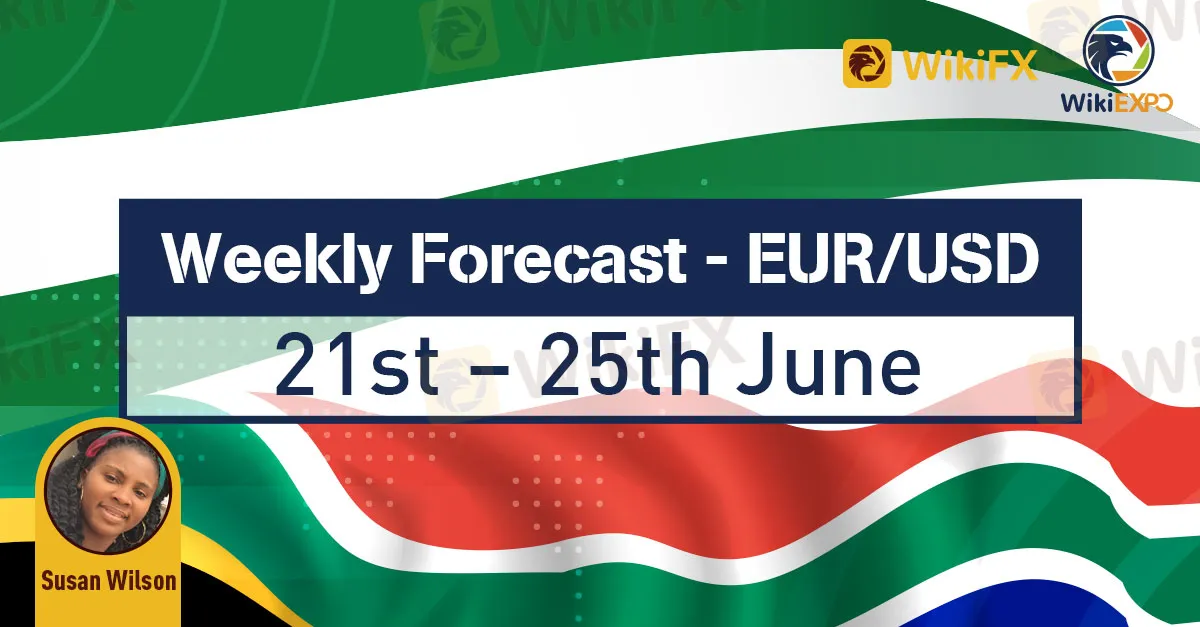简体中文
繁體中文
English
Pусский
日本語
ภาษาไทย
Tiếng Việt
Bahasa Indonesia
Español
हिन्दी
Filippiiniläinen
Français
Deutsch
Português
Türkçe
한국어
العربية
Weekly Forecast - EUR/USD – 21st – 25th June
Abstract:The pair - EUR-USD - plunged to 1.1846, its deepest in two consecutive months, and ended the week very close to such a low. United States Federal Reserve engraved life to the forex markets with a bullish shock, which increased requests for the buck.

Weekly Forecast - EUR-USD – 21st – 25th June
EUR-USD curved bearish in the long-run; decline could spread to 1.1700.
The pair - EUR-USD - plunged to 1.1846, its deepest in two consecutive months, and ended the week very close to such a low. United States Federal Reserve engraved life to the forex markets with a bullish shock, which increased requests for the buck.

Upcoming week - More informs
Statistics-wise, the European Union printed April Industrial Production, which increased to a gigantic 39.3% YoY. However. the Trade Balance surplus diminished to a sum of €9.4 billion. Price rises in the Union were established at 2% YoY in May. The German Consumer Price Index was published at 2.4% within the same period.
The industrial sector is anticipated to have made better than the services one, though the indexes for the US and the EU are expected well into the growth region.
Next Thursday, the United States will put out the last sort of its Q1 GDP and PCE inflation and May Durable Goods Orders. By Friday attention will be on the Nations May Personal Consumption Expenditures Price Index, formerly at 3.6% YoY.
Technical Analysis – EUR-USD
The pair plunged for its third successive week, making its longest weekly weakening for 2021. The long-run depiction proposes that more drops are possible as the pair sits just beneath the 61.8% retracement of its recent rally between prices 1.1703 and 1.2266.
Technical speculations from the weekly chart depict a bearish extension, as the pair has cracked below a now-mildly bearish 20 SMA, while technical pointers curved abruptly lower, and are currently within negative regions.
Also, the daily timeframe shows how bears took over the pair, which presently builds beneath all of its MAs. Technical pointers partly lost their bearish forte close to oversold levels but lacking symbols of changing direction.
The subsequent support line is at 1.1840, trailed by the 1.1770 price level. A plunge beneath this last level should expose the entrance for a trial of the 1.1700 level. EUR-USD needs to improve overhead 1.1985, the 50% retracement of the revealed rally, to have odds of improving more, eyeballing then the 1.2060-70 price region.

Sentimental Analysis – EUR-USD
Bears hold the momentum of EUR-USD, with more investors betting for lower lows. Averagely, the duo is seen at 1.1854, very much unmoved, as hypothetical attention still needs to complete assimilating the recent Feds statement. Bulls expect the pair to improve above the 1.1900 zone on average.
In summary, the charts show that the three moving averages have curved bearish following a long session of ranging. Most price marks amass around or below the current level in the weekly and monthly charts, but those betting for another leg north are still the most in the longer-run standpoint.

Disclaimer:
The views in this article only represent the author's personal views, and do not constitute investment advice on this platform. This platform does not guarantee the accuracy, completeness and timeliness of the information in the article, and will not be liable for any loss caused by the use of or reliance on the information in the article.
Read more

Trading Psychology – 4 Wise Quotes From The Legendary Mark Douglas
In the world of trading, few books have had the impact of Mark Douglas’ big hit Trading in the Zone. Written almost two decades ago, the book has become a must-read for traders looking to elevate their game to legendary status. While there is so much wisdom to be found in the book, we’ve compiled 5 of the best quotes about trading psychology that every trader should read.

EUR/USD Forecast: New lows ahead of the weekend? ECB, covid and technical all point lower.
Optimism has been weighing on the safe-haven dollar – but not against the euro. The common currency's failure to recover is a sign of weakness that could be followed with falls to fresh lows once the mood sours again – and there are reasons to expect that to happen sooner rather than later.

EURJPY WEEKLY FORECAST. Price Likely To Rise Above 131.000.
The price of EURJPY has been on a steady rise ever since it made a low of 128.808. Other currencies collapsed against the Japanese Yen two weeks ago.

AUD Is Weak Under All-rounded Pressure
A rise in the wake of a fall was seen by DXY last week ascribed to the uncertain time of delisting caused by the Federal Reserve (Fed). However, the reason for the rally of DXY last Friday is the vigorous growth of personal consumption expenditures (PCE) released by the U.S. Bureau of Economic Analysis (BEA).
WikiFX Broker
Latest News
Volkswagen agrees deal to avoid Germany plant closures
Geopolitical Events: What They Are & Their Impact?
Top 10 Trading Indicators Every Forex Trader Should Know
WikiEXPO Global Expert Interview: Simone Martin—— Exploring Financial Regulation Change
TradingView Launches Liquidity Analysis Tool DEX Screener
MultiBank Group Wins Big at Traders Fair Hong Kong 2024
'Young investors make investment decisions impulsively to keep up with current trends' FCA Reveals
Why Do You Feel Scared During Trade Execution?
CySEC Settles Compliance Case with Fxview Operator Charlgate Ltd
Scope Markets Review: Trustworthy or Risky?
Currency Calculator


